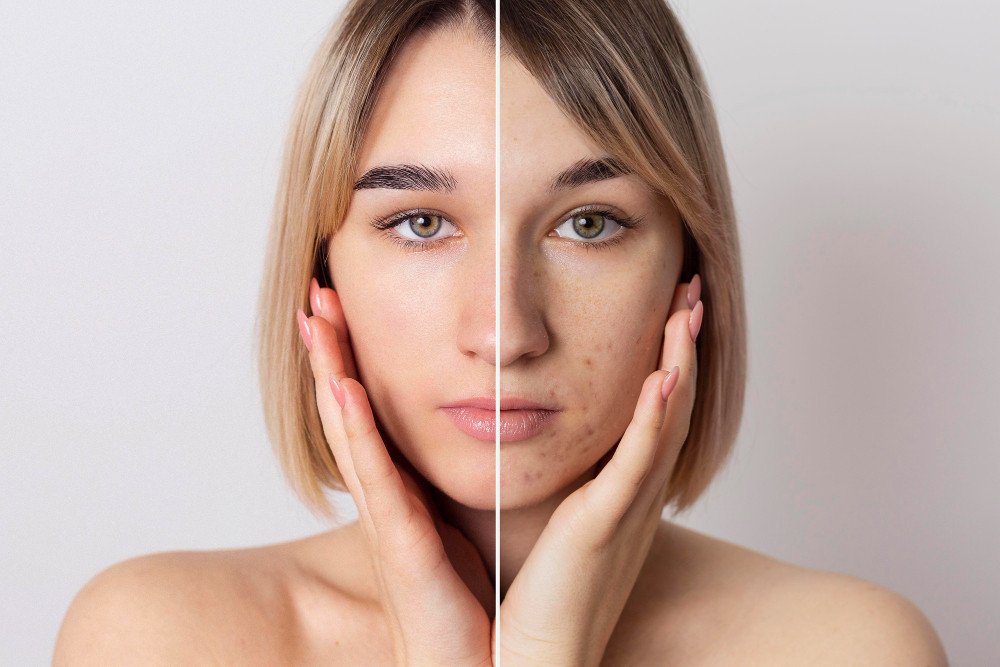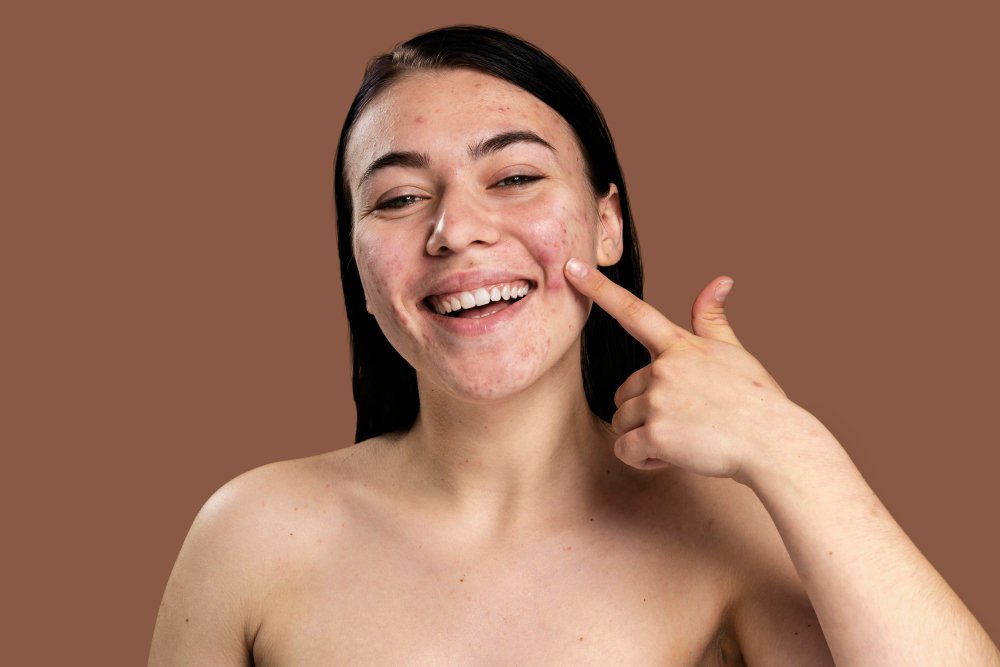Overview of Acne :
Acne is the most common skin Condition.
- It happens when hair follicles, which are under the skin are "Clogged.
- In the skin, the sebaceous gland is present which secretes sebum oil that helps keep the skin from drying out.
- The dead skin cells plug the pores, which leads to backout Outbreaks of lesions. This is Commonly called pimples or zits.
- Pimples zits or acne most commonly occur on the face but can also appear on the back, chest & shoulders.
- It is an inflammatory disorder of the skin.
- Healthy skin contains sebaceous glands which make sebum, that empties onto the skin surface through the pore. It opens in the follicle.
- The keratinocytes are a type of skin cells that line the follicle.
- In the case of acne, all the three
- Hair
- Sebum
- Keratinocytes
It prevents the keratinocytes from shedding off & keeps the sebum from reaching the surface of the skin.
- The mixture of Sebum oil & cells allows bacteria to grow on the skin, which plugs follicles & causes inflammation, redness, heat & pain.
- When the wall of the plugged follicle breaks down, It spills the bacteria, skin cells & sebum into nearby skin, creating lesions or pimples.

Who is most likely to get acne?
People of all races & ages get acne, but most commonly in teens & young adults.
- In teenagers, acne is most common in male.
- In adulthood it is more common in women.
Types of acne?
It includes:
- Whiteheads
- Blackheads
- Papules
- Pustules
- Nodules
- Severe nodular acne
Whitehead: The plugged hair follicles are present beneath the skin and it produces a white bump.
Blackheads: The plugged hair follicles reach the surface of the Skin and open up. It looks black on the skin surface because the air discolors the sebum, not because they are dirty.
Papules: The inflamed lesions that appear as small, pink bumps on the skin & can be tender to touch.
Pustules or Pimples: The papule is topped by white or yellow pus-filled lesions that may be red at the base.
Nodules: The large painful solid lesions that are lodged deep within the skin.
Severe Nodular Acne: The Deep, painful, pus-filled lesions.
Causes of acne:
There are 4 main factors that cause acne.
- Excess (oil sebum) production.
- Hair follicles Clogged by oil & dead skin cells
- Bacteria
- Inflammation
- Pimples are raised as red spots with a white center that develop when blocked hair follicles become inflamed or infected with bacteria.
- Blockages and inflammation deep inside hair follicles produce cyst-like umps beneath the surface of your skin.
Certain things may trigger or worsen Gene:
Hormonal changes – Androgens are hormones that increase in boys & girls during puberty and cause the sebaceous gland to enlarge and make more sebum.
Certain medications best for acne treatment:
Examples include drugs containing corticosteroids, testosterone or lithium.
Diet studies indicate that consuming certain foods including carbohydrate-rich foods, such as bread, bagels, and chips - may worsen acne.
This doesn't cause acne, but if you have acne already, stress may make it worse.
Some myths regarding Acne:
•Chocolate & greasy foods
Eating Chocolate or greasy food has little to no effect on acne.
Hygiene-Acne isn't Caused by dirty skin:
In case of scrubbing the skin too hard or cleansing with harsh soaps or chemicals irritates the skin & can make acne worse.
Cosmetics It doesn't necessarily worsen acne, especially if you use Oil-free makeup that doesn't clog pores & remove makeup regularly.
Complications:
- Scars -Pitted skin (acne scars) and thick Stars (keloid) can remain long-term after acne has healed.
- Skin changes - After acne has cleared, the affected skin may be darker or lighter than before the condition occurred.
Risk Factors:
- Age: People of all ages can get acne, but it's most common in teenagers.
- Hormonal Changes:- Such changes are common during puberty or pregnancy
- family history – Genetics plays a role in acne.
- If both of your parents had acne you're likely to develop it too.
- Greasy or oily substances may develop acne when your skin comes into contact with oil or oily lotions and Creams.
- Frictions or Pressure on your, skin - This can be caused by items such as cell phones, helmet-tight collars & backpacks.
Pimple Removal Treatment:
In Several ways Cosmetologist can help you:
- Control your acne
- Avoid scarring or other damage to your skin.
- Make scars less noticeable.
These medications work by reducing oil production and swelling or by treating bacterial infections.
Many months or years can take to clear your acne completely The Cosmetologist decides your best pimple treatment according to:
- The severity of your acne
- What you are willing to
- The doctor advises you to wash and apply medications to the affected skin twice a day for several weeks.
- Make follow up with your Cosmetologist until your skin improves.
Topical medications:
The most common medications are :
1. Retinoids & retinoid-like drugs are mainly used in treatment for acne on face.
In case of moderate acne we use retinoic acids or tretinoin.
It is available as creams, gels & lotions such as Differin Avage, Tazorac.
Apply this medication in the evening, beginning with three times a week, then daily as your skin becomes used to it.
It prevents plugging of hair follicles.
Do not apply tretinoin at the same time as benzoyl peroxide. Topical retinoids increase your skin's sun sensitivity.
2 Antibiotics
It kills excess Skin bacteria reduces redness and inflammation and helps in face pimple treatment.
In the first few months, we use retinoids & an antibiotic
- Antibiotic applied in the morning
- Retinoid applied in the Evening
3. Azelaic acid & Salicylic acid
- It is a naturally occurring acid produced by a yeast
- Antibacterial properties
- A 20% Azelaic acid is effective when used twice a day.
4. Salicylic acid
It prevents plugged hair follicles and is available as both wash-off & leave-on products.
5. Dapsone:
It is in the form of gel which is used twice a day and recommended as inflammatory acne.
It occurs mostly in women with acne.
Oral medications:
Antibiotics
- In case of moderate to severe acne, you may need oral antibiotics to reduce bacteria.
- In general, the first choice for treating acne is tetracycline and erythromycin.
- It is used only for the shortest time period to prevent antibiotic resistance
Anti-androgen agents
- The drug Aldactane is used for women & adolescent girls if oral antibiotics aren't helping.
- The Possible side effects are breast tenderness and
- painful periods.
Isotretinoin
- It is a derivative of Vitamin A.
- It may be used in people who have moderate to severe acne, hasn't responded to other treatment.
Side Effect -Inflammatory bowel disease:
Severe birth defects
- Therapies
- Light therapy
- A variety of light-based therapies has been tried with some success.
It will require multiple visits
Chemical Peel
In this procedure, we use repeated application of chemical solutions such as -Salicylic acid, glycolic acid, or retinoic acid. It is used in mild acne.
Drainage and Extraction
It may use special tools to gently remove of whiteheads and blackheads or cysts that haven’t cleared up with topical medication
Steroid injection
Nodular and cystic lesions can be treated by injecting a steroid drug into them.



0 Comments:
Leave A Comment
Your email address will not be published. Required fields are marked *